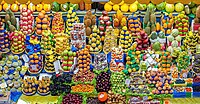
Photo from wikipedia
BACKGROUND The different parts of pomegranate fruit are considered powerful mixture of bioactive compounds yet the peels and pulps of the fruits are usually discarded and considered as industrial waste.… Click to show full abstract
BACKGROUND The different parts of pomegranate fruit are considered powerful mixture of bioactive compounds yet the peels and pulps of the fruits are usually discarded and considered as industrial waste. In this work, UPLC-QqQ -MS was utilised for metabolomics analysis of different parts (peel, pulp, seed and juice) of pomegranate fruit cultivars to verify possible variations among the fruits and their waste products as potential sources of functional constituents. RESULTS Orthogonal projection to latent structure - discriminant analysis (OPLS-DA) coefficient-plot showed enrichment of phenolic compounds such as punicalagin and ellagic acid derivatives in pulp samples while seeds class was enriched in phlorizin, catechin and quercetin, juice class showed abundance of naringenin and pelargonidin-3-pentoside while peels were enriched in anthocyanins and flavonoids including cyanidin diglycoside, quercetin and luteolin glycosides. Although the juice samples of almost all tested cultivars showed remarkable cytotoxic activity, yet the pulp samples, particularly the Manfalouti cultivar, exhibited the most potent one (IC50 = 2.367 ± 0.14 μg/ml in MCF-7, IC50 = 3.854 ± 0.23 μg/ ml in HepG-2 cell lines). OPLS models were constructed for determination of cytotoxicity-associated metabolites among where the coefficients plots revealed tannins; granatin A, ellagic acid derivatives, punicalagin α and β, in addition to anthocyanins and phenolic compounds; cyanidin diglycoside, quercetin, phlorizin, 3-O-caffeoylquinic acid, naringenin and liquiritin were more pertinent with cytotoxicity of the different parts of pomegranate fruit. CONCLUSION The results obtained allows for full utilisation of the resources of pomegranate fruit and its industrial waste as source of bioactive compounds. This article is protected by copyright. All rights reserved.
Journal Title: Journal of the science of food and agriculture
Year Published: 2022
Link to full text (if available)
Share on Social Media: Sign Up to like & get
recommendations!